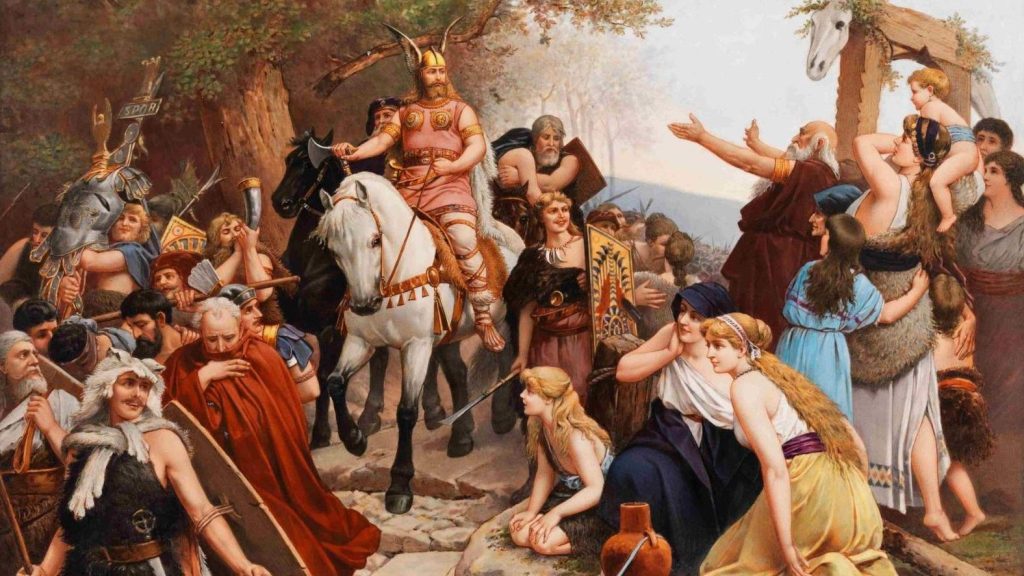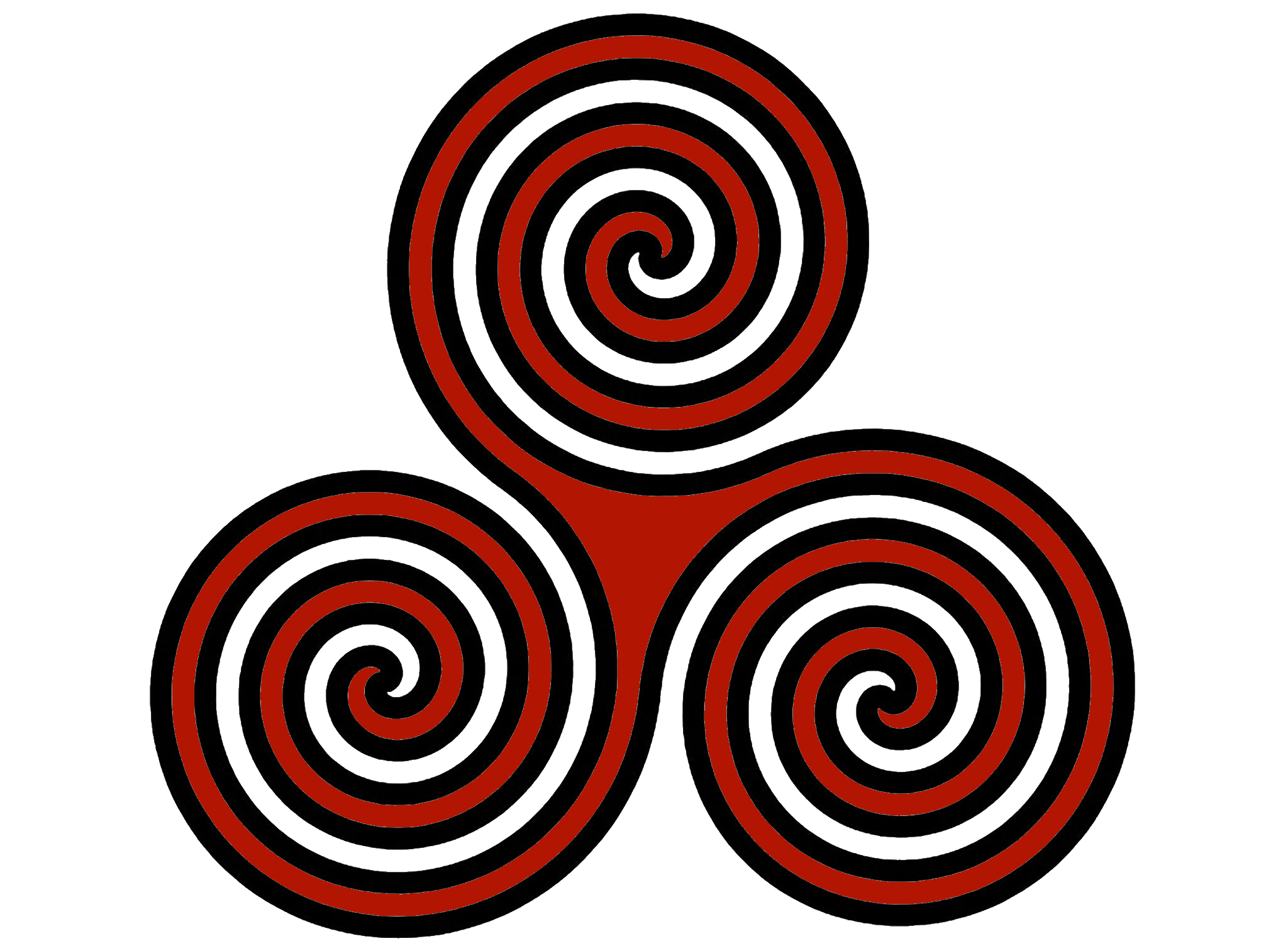Celts and Germans (Random thoughts and myth comparison)

Germans, Celts, Manus, Teutates-Toutatis, Tuisto Etc.
The Celtic God Teutates is described by Roman writers as a Celtic God of War, associated or compared with both Murcury (Woden) and Mars (Tiw). It is said he was one of 3 major Gods worshiped by the Celts in Gaul and Britain (Taranis = Thor)
Esus (Ing) and Teutates (Tiew/Woden). In Tacutus’s Germania he describes the first information of Germanic tribes to be recorded: That they worship an Earth Born God called “Tuisto” or Tuisco* (*cognate to Tiw) earlier reportedly meaning “Two” or “double” and the later being possibly cognate to Tiw. Is Teutatis and Tiw (Tiwaz) somehow related? Is Tuisto in fact Teutatis and the name sake of the Tribes of which the Germans take their name (Deutsch).
Are Teutates, Taranis and Esu cognate to Woden þunor and Ing.
War, Thunder and Lord.
Celtic Sea God Manannán cognate to Germanic Manus? Manannan is described as a Tuatha Da Danan (People of Danu) a tribe of divine beings that inhabited Britain before the humans arrived. The Milesians (Celts or Scythians) then inhabited the Islands. Are the Tuatha Da Danan a reference to a Teutonic people previously inhabiting Britain? According to the Book Blood of the Isles (which did DNA surveys on Britain) found that Scotland particularly had a surprisingly high migration rate from Scandinavia during the Beaker and later bronze age.
The God Manannan has interesting comparisons to Ing or Freyr:
One:
Freyr is son of Njorð a Sea/Fertility God.
Manannan is son of Ler a Sea God
Two:
Freyr has a magic boat that fits in his pocket.
Manannan has a magic boat that guides itself.
Three:
Freyr has a magic sword which fights on its own.
Manannan has a magic Sword that steals his enemies strength.
Four:
Freyr has a magic boar he rides and is associated with horses/horse cults.
Manannan has a magic horse who rides over sea and land (Also Sleipnir like)
Both Celtic and Germanic myth describe a primordial Race of Giants being in conflict with the Gods of order. Greek myth which is also Indo European has Titans as the primordial beginning. The Germans have Ettins/Jotuns or Eotens and the Celts have
Formorians.
The Tuatha Da Danan Battled the Formorians in Celtic myth as the Vanir Battle the Æsir in Norse or Germanic although Vanir does not exist outside later Norse sources. It is unknown if the Eldest kindred of Teutons (Germans) acknowledged a difference between Gods or saw them as having tribes. Perhaps it was simply a matter of Æsir and Jotuns as the Vanir are descended from Jotuns technically. Elements of Celtic mythology appear to almost reference the settling of the Indo-Europeans across Europe and even place the Tuatha Da Danan as the northern most of these groups. (Later they are the Pagan Irish Gods).
Were the Formorians and Fir Bolg Hunter Gatheres and Neolithic Farmers?
While the Earliest Teutons share a vague Celtic attachment none are more vague than the Belgae:
The Belgae are both linked to the Cimbri and in their own words spring from the Germani a tribe who’s name later becomes a catch all for for all Germanic speaking people. Many of the Belgae names and descriptions say they are in fact Celts but signs of a true mixture of the two groups appears to be in sight. They are hostile to the Gauls but apparently can speak a form of Gaulish. The name Belgae has both Proto Celtic and Proto Germanic etymologies. It is said to mean swelling with anger or battle fury. Caesar states they are the most Brave and when he asked them of their deeds they stated that the Cimbri and Teutons failed to invade them. It is said later the Cimbri led partly to the Belgae as a people. There is inconsistency here.
The Belgae and Gauls are both said to wear winged or elaborate horned or crested helmets. The Celts wore Boar crested helmets as well did Germanic tribes. The Winged Helmet although the accuracy unknown was often attributed to the Teutonic tribes.
It should be noted the practice of Bog Sacrifice seemed to be held across Britain and Southern Scandinavia/Germany and the Nordic Bronze age shares more than a few traits also seen in the Bronze age portion of of the Hallstatt Culture which reached from its origin in Central Europe to the Balkans, Britain Germany and Netherland/Belguim/France. How far North it spread is unknown but the Gundestrup Cauldron appears to be of Balkan Celtic origin.
Sorry if this seems disjointed but it was a thought stream.
Hroð-
Celtic Word of the Day: Alba/Alps
Celtic Word of the Day: Alps
Focal Ceilteach an lae: -Albiyu-Alba
Alps-Alpine (The Alps, a Mountain Region, Mountains) The word Alps, Alpen, Alpine are derived partly from Latin but Latin borrowed it from Proto Celtic Albiyu. Albiyu in Proto Celtic means Luminous world, upper world, mountains or in later use Britain as a whole. Scotland once called Alba meaning “White” likely after its snowy white mountains. In German languages “Alb” became just a term for high mountains specifically The Alps. Example “Swabian Alb”. Albiyu is derived from Proto Indo European *h₂elbʰós meaning “White”. We also get the word Albino from this etymology. The dominant pre Britain homeland of the Celts existed in The Alps of France, Germany, Italy, Switzerland and Austria. The Austrian Alps is arguably the homeland of the first Celtic People who arose from the Hallstatt Culture. The municipality of Alba in Spain is likely derived from Celtiberian speakers who populated Iberia before Latin speakers expanded from The Italic peninsula. This is a very well distributed Celtic loan word.
Brythonic: *ėlβɨð
Old Welsh: elbid
Middle Welsh: eluit, eluyd
Welsh: elfydd
Goidelic:
Old Irish: Albu (“Scotland”)
→ Middle Welsh: Albbu
Irish: Albain, Alba
→ Welsh: Alban
→ Cornish: Alban
→ Latin: Albania
→ Middle English: Albany
English: Albany
Manx: Nalbin, Albin, Albey
Scottish Gaelic: Alba
Hispano-Celtic:
→ Latin: Albiones (ethnonym)
→ Ancient Greek: Ἀλβίων (Albíōn), Ἀλουΐων (Alouḯōn)
→ Latin: Albiōn
→ English: Albion
→ West Germanic: *albijā
Old Saxon: elbon
Old High German: alba, Albūn
Middle High German: albe, Alben
German: Alpe, Alp, Alm, Alpen
→ Latin: alpis, Alpēs
→ English: Alps

Hroðbeorht-
Oíche Shamhna bheannaithe

The veil thins.
The Harvest is brought.
The mounds open.
The mead is poured.
The fires are lit.
An Ancestral night.
A bonfire night.
Summers end.
Hroðbeorht-
I hope my spelling and grammar are correct….checked them twice but I am not quite comfortable yet with Celtic language structure.
Ogma (Warrior Poet and Inventor of the Ogham)

(Lee Lawrie, sculpted bronze figure of Ogma (1939). Library of Congress John Adams Building)
Ogma is a God among the Tuatha De Danaan who challenged Lugh and after being bested became Lugh’s bravest champion. He was known to the Gauls as Ogmios and compared to Hercules in that several elements of both myths have similarities. Some elements however are missing such as Ogma does not carry a club but a sword in the Celtic myth. Ogma also has a host of followers by which are tethered with golden chains. If his right hand a sword and left a bow then how does he lead his host? The chains are attached to his tongue. This is an allegory because Ogma is a God of poetry , glib speech and eloquence thus demanding loyalty through pragmatism.
He is the famed mythological creator of the Ogham script, an early medieval script found amongst Gaelic and Pictish tribes. The origin of the script is unknown and many opinions have been put forth but it is unique compared to Latin and even Runic alphabets. Each is named for a tree, most inscriptions are names but some inscriptions are still somewhat mysterious.

An interesting part of the myth around Ogma is that he is the father of Taranis (Celtic thunder God) and like Odin is a God of poetry and Father of Thor the Thunder God. I find it very interesting that so many Celtic Gods seem to encompass elements of Odin. Odin hung from Yggdrasil and reached into Ginnungagap to grasp the Runes. Ogma a God of eloquence carved the Ogham, his name etymologically infers to cut. He appears in a trio of Gods (Lugh, The Dagda, Ogma) called the “Trí Dée Dána“. The Celtic Gods appear in similar tradition to Slavic in that here we have the “Trí Dée Dána” and Slavic lore we have Triglav, a three headed God sometimes comprising three different Gods in one. There are several carved stones depicting three faces believed to represent a Celtic God. Ogma is The Dagda’s brother and Lugh’s half brother. The term “Trí Dée Dána” is also used for other characters.

Above image is Public Domain (Wikipedia)
Comparative Myth: Ogma/Odin:
Odin is the father of Thor the Thunder God and mastered the Runes. Odin is the blood brother of Loki.
Ogma is father of Taranis and inventor of the Ogham script. Ogma is half brother of Lugh who may share name etymology with Loki.

Book of Ballymote. Public Domain (Wikipedia)
Hroðbeorht-
Samhain Month (Mi Na Samhna)
Samhain the Celtic harvest and opening of the gates to another world.

Gaston Bussiere, Beatrix Elvery and unknown. Compilation image and photo by Hroðberht.
Some Legends:
Samhain is well known for the exploits of legendary Gaelic hero Fionn Mac Cumhaill and his Battle on Samhain night against the fire breathing Giant Aillen. Believed to be symbolic protection against fire. Samhain was also the second Battle of Mag Tuired in which the Tuatha DE Danaan battle the Fomor for the final time. Traditional Samhain has much to do with Ancestors, spirits, ghosts and the beings of the mounds of shadowy corners. It was a time of celebration, feasting and harvest before the coming of the dark half of the year. Sacred Bonfires would be lit across the land and Druidic prophecy foretold.
The hero Nera is said to have embarked upon a journey into the non corporeal world where he encountered Faries and the Undead. One Samhain night The Warriors of Cruachan were feasting and their King Aillil dared any man to put a wicker band around a corpses ankle that had been hung. Samhain is a night when the dead walk. Nera A warrior of Connacht was the only one brave enough to accept the challenge. As he placed the band upon the corpse it moved and asked him to give it water, Nera allowed the undead being to climb on his back and carried it to a house. The first house was in flames, the second flooded with water but the third they could enter. The corpse drank 3 cups of water, spitting the third out killing those in the house. Nera returned the corpse to the gallows only to find the hall in flames with all inside decapitated. He saw a host riding back into the Cruachan and followed them into the otherworld. Once in the mound he met one of the female Sidhe (She) who told him that it was not real but a vision of the next Samhain night if the warriors of Medb and Aillil did not destroy the Cruachan and defeat the army of the Sidhe. Nera returned to tell Queen Medb and Aillil of what he had heard and seen only to find no time had passed since he left on his quest. Nera warned the people of Cruachan before escaping with the woman Sidhe. Medb, Aillil and Fergus Mac Roich then went to destroy the Hill of Cruachan.
https://www.history.com/topics/holidays/samhain
https://www.newgrange.com/samhain.htm
Hroðberht-
